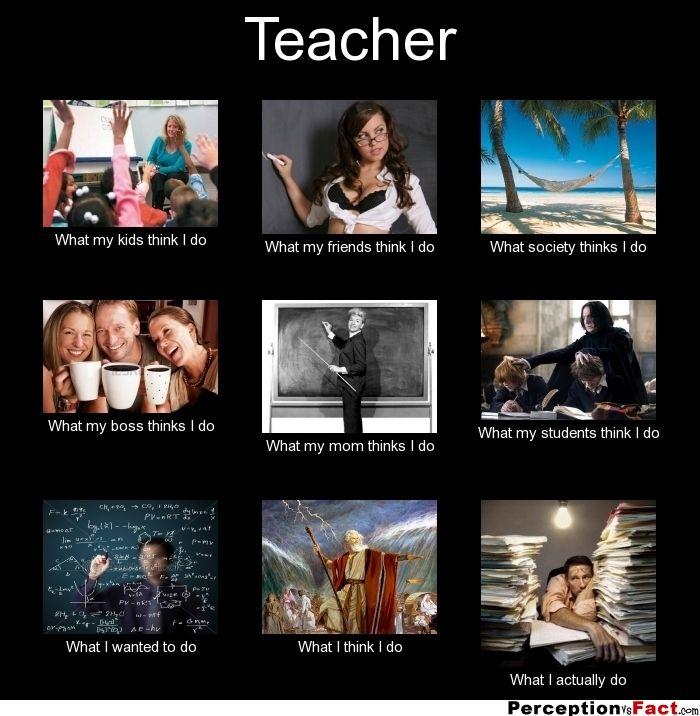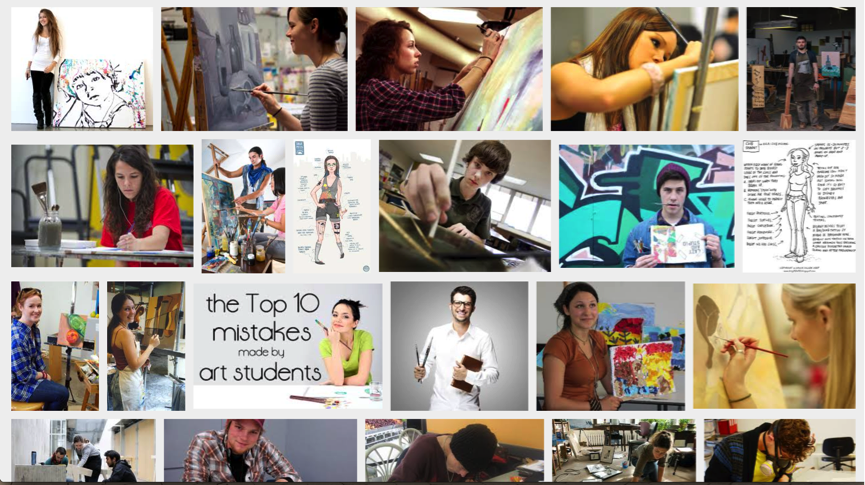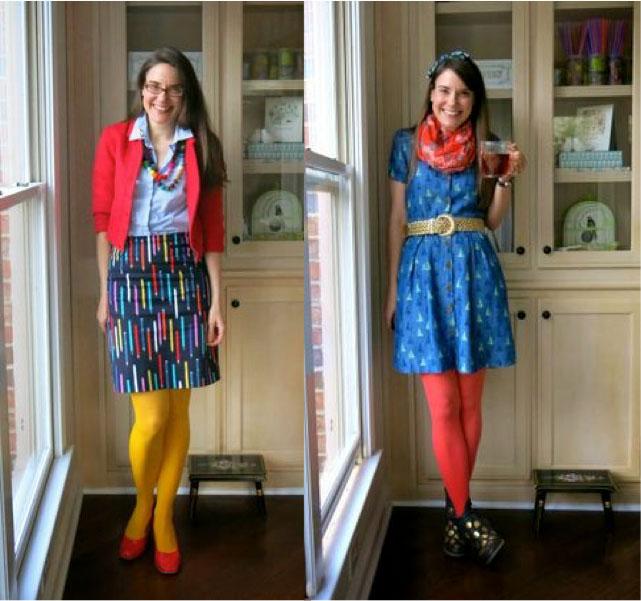
Being a teacher
An exploration of identity mechanisms
How authentic, unique or anti-establishment you might think you are, this paper shows that there is no escape to some universal identity mechanisms. However universal, these are the mechanisms that make you feel authentic, unique and at home in a community.
Introduction
When I was a child I used to watch ‘Jeugdjournaal’ (the newscast for children) every night. This newscast had the same format as the regular, adult newscast but paid more attention to topics that would appeal to children. I remember always noticing the edited references of the interviewees. The interviewee usually was someone’s dad, teacher, classmate or sister. I used to fantasize about myself being interviewed by a reporter of Jeugdjournaal and was wondering in which role I could be the necessary interviewee. So I began to internally summarize what I was, a sister, daughter, classmate, fan of Bert and Ernie, friend, niece, student of the local primary school, inhabitant of my street and village and so on. I realized this would be an on-going list and the content would change when I grew older. Being this aware and well prepared for an interview it is a pity the actual interview never happened. Nevertheless does this memory contain my first thoughts about identity, small niches and micro-hegemony, obviously not knowing these words existed for my structure of thoughts.
I did not see myself drink lipid black tea because I was too busy keeping the students in order.
Growing up, my identity became even more fragmented than when I was a child, but less open and mouldable. Becoming more self-conscious results in identity changes but also in identity choices. Who do I want to be? Which acts of identity support that image? How do I handle uncomfortable situations? To get grip on this image building a personal matter will be explored, because of ‘Discourses in which people identify themselves and others include a bewildering range towards which such people express affinity, attachment, belonging; or rejection, disgust, disapproval.’ (Blommaert & Varis, 2015: 6) This paper enlightens only a few expressions of identity.
When the high school where I currently work offered me a job as an art teacher four years ago, I accepted it with doubts. Not even graduated from the academy of arts I did not see myself working with underage children, did not see myself siting in the teachers’ lounge and did not see myself drink lipid black tea because I was too busy keeping the students in order. This self-concept changed over the years. This paper will analyze the working mechanisms in identity and self-concept, studying the case of my transformation from an art student to an art teacher.
Micro-hegemonies in a professional sphere
When one enters ‘Teacher' in Google the images depicted in figure 1 pop up. The first thing to notice is the prevailing uniformity in the different images. The typical chalkboard is instantly recognizable, present in every photo yet absent in every classroom. The unmistakable smile on every figure's face exposes a relaxed and in control attitude. We also see every figure communicate with either the viewer or a student. In almost every image we see the teacher depicted from the waist up. Furthermore we see a flawless dress code of white blouses, ties and pastel coloured tops. Altogether it shows a classic example of a stereotype.
Figure 1 Reprinted from google entering ‘Teacher’, retrieved oct, 26, 2015
When we look at one of the circulating memes about teachers on the Internet, as depicted in figure 2, we see more stereotype ideas occur. Instead of stereotype visuals, this meme displays the stereotype ideas that exist around teachers.
Figure 2, Teachers meme, retrieved oct, 26, 2015
This web-based orientation gives an insight on the stereotype view society has on teachers. The semiotic features exposed in both figures create instant recognizability to the viewer. This makes a strong stereotype, but as is typical for a stereotype, it exaggerates details and it only slightly corresponds with real life. When we distillate the similarities of these images we can conclude that:
- Teachers dress appropriately
- They wear outfits that do not expose a lot of skin.
- They stand in front of a chalkboard
- They communicate actively with someone else. In doing so they seem in control and relaxed.
When looking at figure 2 we see that figure 1 only depicts ‘what my mom thinks I’m doing’ which can be interpreted as what someone with full confidence and a slightly naive attitude thinks a teacher does. We now see other aspects of the teachers’ image occur. A teacher is supposed to be someone with a lot of vacation, who drinks coffee all day, who is very strict to students, someone who actually dreams of performing the subject himself, who wants to show the right direction to others but is actually buried in tests and other paperwork.
Even though there is no actual teacher depicted, the images with their captions are very recognizable. All those features combined represent a teacher, some features are only recognizable for the community itself, i.e. being buried in paperwork, while other features are only recognizable for the others outside the community, i.e. being very strict to students.
When I entered the world of teachers –and I must admit that my personal stereotype ideas were even worse than the ones described- they did not look or act the way the stereotype implies. Some of them did carry a typical briefcase, drank coffee all day or were buried in paperwork, but most of them would not be recognizable outside the school. Surrounding students would be the only uniform feature that represents a teacher. The other potentially emblematic features are arranged in a specific way, these features together make a teacher recognizable as being one.
A teacher is supposed to be someone with a lot of vacation, who drinks coffee all day, who wants to show the right direction to others but is actually buried in tests and other paperwork.
The community of high school teachers can be seen as a coagulated aggregation of different identities or as a light community: a community which, in a certain setting, is recognizable as a specific community, but without the specific setting and connecting norms the group shatters in a multitude of different identities (Blommaert & Varis, 2015). We saw that separately visible features are not always enough to create recognizability; the behavior and norms are also of importance.
Figure 2 showed examples of behavior that are considered to be indexical for teachers; drinking coffee all day, being strict to students. But those features are not the dominant features that define the behavior of a teacher. Analyzing teachers I have met, the following indexical behavioral features, amongst others, would define a high school teacher in my view.
- Conversing with, to or about students
- Showing responsible behavior. Acting in a responsible way
- Being open to the surrounding activity
- Being social, not being shut off.
Figure 3 Screenprint of google entering 'art student', retrieved oct, 26, 2015
Figure 3 reflects a very different image than the images that were displayed when one enters ‘teacher’ in Google. We now see individuals photographed from different angles. Some of the depicted figures communicate actively with the camera but nearly half of them focuses on the work of art they are making. The clothes they wear show more variation except for the lumberjack blouse that appears three times. From personal experiende I would sugest a more intens focus on the dressing code than exposed in this quick Google search. Of course the image of an art student stretches also further than visible features only. If we look at the emblematic behavior and norms of art students in contrast to the behavior and norms of teachers some large differences occur.
- They create art
- They focus on themselves or their work instead of on transmitting information
- They explore social boundaries.
To understand how these social groups come into existence Hogg and Reid explore the idea of the prototype or a group of prototypes that is tied to social categories and identities. In order to define this prototype they use Tajfel's definition of the social identity. Tajfel originally defined this identity as : ‘ …the individual’s knowledge that he belongs to certain social groups together with some emotional and value significance to him of this group membership.’ (Tajfel, 1972: 292, as cited in Hogg & Reid 2006) As soon as the prototypes are being anchored in a social setting they become normative. When the social norms are set they influence and attract others because of the normative beliefs that are constructed and modified through interaction with other people (Hogg & Reid, 2006). Even though the groupnorms are anchored by one or more prototypes the group norms stay highly dynamic. The idea of a social prototype gives an explanation for how group norms are set but does not declare the tremendous pressure to live up to these norms.
Christensen et al. (2004) give a plausible explanation of how the process of identification works:
‘Two studies demonstrated that greater identification with a group was associated with more positive emotions for members who conformed with versus violated the group’s norms. These effects were found with injunctive norms, which specify what members should do or what they ideally would do, but emerged less consistently with descriptive norms, which specify what members typically do. Descriptive norms affected emotional responses when they acquired identity-relevance by differentiating an important in-group from a rival out-group. For these descriptive norms, much like injunctive norms, greater identification yielded more positive emotions following conformity than violation.’ (Christensen et al, 2004: 1295)
Norms guide behavior to the extent that people have adopted the relevant group identity. When one is motivated to belong to the in-group instead of the out-group, one conforms to the norms instead of violating them.
Recapitulating, the previous section explored the image and emblematic features of respectively the teacher and the art student. The features of these light communities appeared to be highly contradictory. To understand how the process of transitioning from one community to another works we looked in to social norms. It appeared that the prototypes that define the norms of the community exert influence on other members. When motivated to avoid violation of the group norms, the out-group conforms until they adopted the relevant group identity. But within this pressuring movement toward conformity there is also space for uniqueness. The following section will explore authentic niches of identity within the restricting corset of norms.
Details in identity
We concluded that, when out-group members are motivated to become in-group members, they conform to the norm until they have adopted the relevant group identity. When we look at the community of teachers we see that the in-group teachers, who are conforming to the norm, do not look the same and still have their own –adjusted- authentic behavior. Blommaert and Varis (2015) recognize these small distinctions and declare that: ‘Identities and senses of ‘being oneself’ are based on and grounded in miniscule deviations from standard formats and scripts that organize most of what this ‘being oneself’ is actually about.’ (Blommaert & Varis, 2015: 16)
When we return to my personal case I would say that although I conform to the teacher norms, I did not loose the art student visuals completely. In order to show that I am an art teacher and not any other teacher I display details to indicate that distinction, using semiotic features to offer others a readable script. To show how the culture of detail works we zoom in on the teachers’ dress code. The Internet is full of examples and ‘inspiration’ of how a feminine teacher should dress. Figure 4 and 5 show examples of this norm, showing a very descent way of dressing with skirts just above the knee or long trousers and covered shoulders. The flat shoes, the jacket or vest seems also typical for the teachers’ look.
Figure 4 Example of the teachers outfit I, retrieved Oct, 29, 2015
Figure 5, example of the teachers outfit II, retrieved Oct, 29, 2015
Figure 6, Example of the arts teacher outfit, retrieved Oct, 29, 2015
When figure 6 is compared to figure 4 and 5 we see one deviation that stands out. The amount of colours and prints matched in one outfit makes a member of the community of teachers immediately categorize this person into the subgroup of art teachers. One could even discuss if we are talking about an accent here because the colours are so overwhelming. When we look closer we can distinguish more similarities than deviations. The skirt above the knee, covered shoulders, the blouse and blazer also refer to an appropriate way of dressing. The typical glasses in the left photo and cup of tea in the right photo add an extra reference to the teachers’ identity.
The dress code showed above is not the only way an art teacher could dress to be recognized as one but it does show very clearly the recognizable details used in order to create a specific identity niche. It needs to be emphasized that these semiotic features are highly dynamic and the ‘reader’ needs to have affection with the culture or community to be able to understand them.
These choices of detail occur in visible features but also in behavioral features. The norms dictate the borders of communities in terms of enoughness and emblematic features but leave space for deviating semiotic details. Society strongly pressures towards conformity on every level. However, details give some space to express personal features of style and identity.
Virtual identity and privacy
Up to this point the paper explored identity in general and my professional identity in particular. It appears that we are able to be a member of a multitude of communities and adjust to different norms. Within the norms one could use accents to express personal style. ‘…it is clear that identity as a singular notion has outlasted its usefulness – people define their ‘identity’ (singular) in relation to a multitude of different niches – social ‘spheres’ in Bakhtin’s famous terms – and this is a plural term.’ (Blommaert & Varis, 2015 p.5)
Because of the student's habit to track their teachers' online traces, my self-regulation reaches to the extent that I reconsider all my online action.
The Internet adds another dimension to examining identities that is incomparable with structures found in offline life. It creates ‘transparency’ in identity. Although the word transparency is currently in fashion in terms of corparate management, in this case it brings some consequences or at least adds new questions to the construction and readability of contemporary identities. Concerning the mechanisms of identity we discussed earlier three major web-based issues emerge.
- The first issue relates to the fact that it is hard, sometimes impossible to remove online content, either published by you or by someone else. Later in life it is more difficult to adjust your visible image when your offline identity has moved to another direction.
- In contrary to face-to-face identity that is constructed under a variety of constraints, the online environment enables individuals to create an ideal identity, ideal to this point in life. When people create this virtual image of desirable features they add a new layer to the social reading of their identity.
‘… a person’s conception of himself or herself can be distinguished by two categories: the ‘now self,’ an identity established to others, and the ‘possible self,’ an identity unknown to others. Users can achieve the latter state by withholding information, hiding undesirable physical features, and role-playing.’ (Mehdizadeh, 2010, p358)
3. The most important consequence of the transparency of identity is the violation of privacy. Privacy is necessary to conform ourselves to different community norms until we feel comfortable and can identify with those norms. Individuals present themselves differently in different situations and environments: they appeared flexible to adjust to different norms in different situations even when those norms seemingly contradict each other. These changing attitudes or micro-hegemonies (Blommaert & Varis, 2015) are part of contemporary life and of the construction of identity.
The perception of others changes if irregularities in identity are always visible and transparent to everyone. When we take a look at my online traces we see an image that departs from the image I expose within the school, more than my professional image alone defines my online identity. Because of the student's habit to track their teachers' online traces, my self-regulation reaches to the extent that I reconsider all my online action.
This panoptic situation is opposite of offline life, where the teacher would administer this normalizing power. The Internet provides transparency that leads to opposite directions of power that could make it hard to adapt to different micro-hegemonies at the same time. This personal example is only the top of the iceberg concerning the consequences transparency has on the construction of identity. On the other hand the Internet offers an immense range of possibilities to expose and commodify one's identity in many different ways.
Conclusion
Although this paper only scratches the surface of the construction of identity it makes clear that there are many social processes active at the same time on different levels. On personal level we see the importance of detail to create an authentic image of the self. These personal details or style give persons the sense of individuality or the reference to a –sub-group. Although this seems an act towards the self it actually is a sign that can, and has to be, read by others to succeed. The visible features that seem a product of free choice subdivide individuals into groups or communities. Either as an act of authenticity or of group conformation, the features have to be recognizable to have an impact on and to belong to a certain group. It appeared to be possible to adapt the visible group features not only trough a feeling of belonging but also by a changing environment.
On the level of the social group there are more mechanisms active to guide the individual towards to or away from a community. Hogg and Reid (2006) mentioned the importance of a prototype to create and carry out the group norms. Even though these norms are set, they can remain highly dynamic. Who conforms to the group norm is considered to be the in-group, they are able to judge and reset the group norms. The ones in the out-group have to conform to the group norms to become a member. In this process the importance of enoughness needs to be emphasized. Being a member of the in-group one can judge the enoughness of the necessary features. To be a member of the group, one needs to have exactly enough.
Contrary to violating group norms identifying with the group norms generates positive emotions. This results in a social pressure towards conformity. Nevertheless it remains possible to act contradictive in different situations and different moments without violating group norms or the idea of authenticity. The ability to flexibly adjust to different situations is put under pressure by the virtual identity. The virtual identity that is always visible for everybody is consciously or unconsciously linked to the connected off line persona. The difficulty lays in the fact that the virtual image can on the one hand be insufficient to show the full dimension of the identity and on the other hand it can display a desirable self that does not relate to off line life. Because the virtual image is hard to adjust and can always be inquired, it is difficult to adjust behavior as flexible online as offline. However, the opportunity to show the world the desired or artificial identity also provides the individual the power to influence groups in a way that would be impossible in offline life.
References
Blommaert, J.& Varis, P. (2015) Enoughness, accent and light communities: essays on contemporary identities, Tilburg Papers in Culture Studies,139, Tilburg University
Christensen, P.N., Rothgerber, H., Wood, & W., Matz, D.C., (2004) Social norms and identity relevance, a motivational approach to normative behaviour, Personalit and Sociol Psychology Bulletin,vol. 30 no. 10, pp.1295-1309, doi:10.1177/0146167204264480
Hogg, M.A. & Reid, S.A. (2006) Social identity, self- categorisation and the communication of the group norm, Communication Theory 16, International Communication Association, doi:10.1111/j.1468-2885.2006.00003.x
Mehdizadeh, S (2010) Self-Presentation 2.0: Narcissism and Self-Esteem onFacebook, Cyberpsychology, Behavior and Social Networking, Volume 13, number 4, doi: 10.1089=cyber.2009.0257





